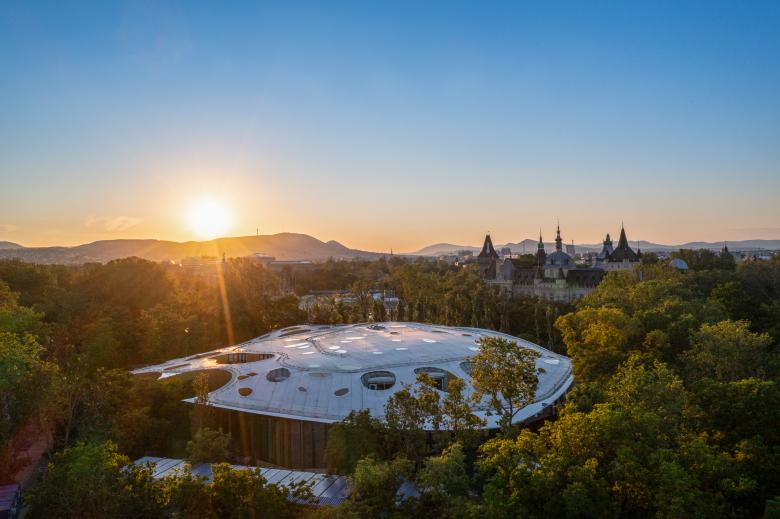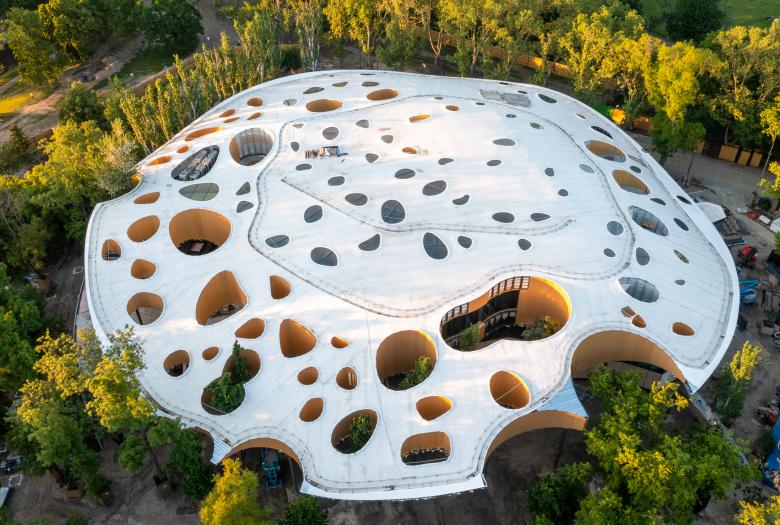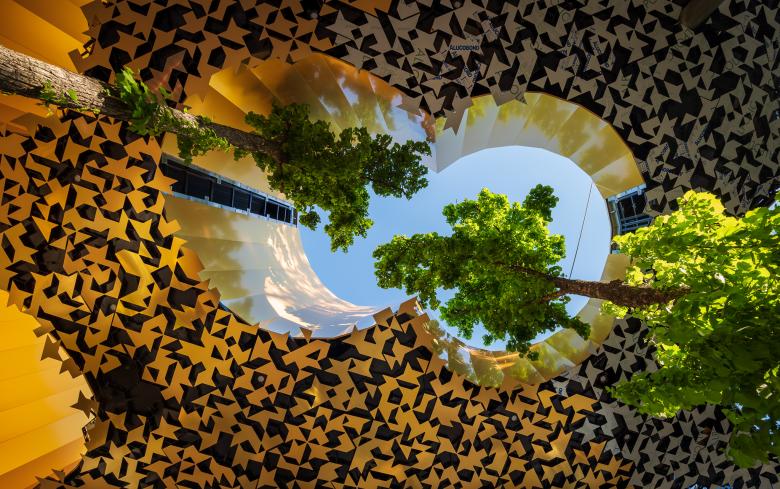Sou Fujimoto’s Wave-Like House of Hungarian Music in Budapest
Vibration of Sound
The House of Hungarian Music in Budapest's City Park will open to the public at the end of January. Sou Fujimoto's design is an undulating canopy above glass walls that is all about blending the new building into its natural setting near the city center.
About ten years ago Sou Fujimoto was instantly catapulted to international fame, when his all-white, ultra-thin houses were met with widespread acclaim. While they may not always “work” in everyday life, their concepts are stunning, radical, and elegant. With the “L’arbre blanc” in Montpellier, France, Fujimoto recently had to prove that his radical suggestions are buildable in faraway places outside Japan and on a bigger scale. His idea that “the function of a building is decided by human behavior” was cast in a tree-like apartment tower along the shore of the Lez river, where wide white balconies around the kidney-shaped tower shoot into the air.
The leitmotiv of a tree is also at the core of the House of Hungarian Music that Fujimoto designed as part of the Liget Project, Europe’s largest urban cultural development; the building is set to open its doors in January. At first glance, the undulating, perforated roof above glass walls looks like a mix between Shigeru Ban’s Hanegi Forest apartment building and SANAA’s Glass Pavilion at the Toledo Museum of Art. Both the idea of erecting a building around existing trees and the notion of curved glass walls dissolving any boundary between interior and exterior were explored beforehand by these two projects designed by fellow Japanese architects. At the House of Hungarian Music, the graceful transparent surfaces blend the building into its surrounding park, Budapest’s largest.
The House of Hungarian Music claims to be the “world’s first facility of musical initiation” offering exhibitions, concerts, and workshops. “The House accommodates a triad of exhibitions, live music and music education in one venue,” says András Batta, the director of the House. It has three levels: below ground are exhibition galleries, including a permanent exhibit on the history of music and a sound dome — a hemispherical cupola that features different “sound spaces.” The ground floor is devoted to the performing arts with concert halls and an open-air stage, while the terrace near the Lake of City Park will be a place for recreation. The top level houses an archive of pop music and music education rooms. Overall, it evokes the atmosphere of musical pavilions.
The House of Hungarian Music was built near Heroes’ Square, on the site of a demolished office block. Fujimoto’s design, with the concept of blurring the boundary between the natural and built environments, was selected from 168 projects in a competition. The organic roof is intended as “a representation of the vibration of sound: the wave.” The open floor plan is lit from above using openings in the roof that admit light “like the foliage of trees.“ Fujimoto recalls: “It was inspiring to work in one of the world’s first public parks, since we brought the park into the building.” The glass walls, consisting of 94 custom-manufactured heat-insulated panels that reach up to 12 meters tall, lend the building full transparency. The playful, undulating canopy of varying depth — punctured by 100 individually designed holes, some for trees — stays below the tops of the trees, ensuring that the building blends into its environment. There are no right angles in the roof and almost no two elements are the same.
The heating and cooling uses renewable energy in a “tele-cooling system.” Additionally, some 120 heat pumps were installed 100 meters underground in a nearby park, Nagyrét, north of downtown, to provide geothermal energy. These and other features of the building helped it gain an “exemplary” rating by BREEAM.
The House of Hungarian Music is Sou Fujimoto’s first major cultural building in Europe, but it will soon be followed by a higher-ed building, when in February the university of St. Gallen in Switzerland opens SQUARE, formerly known as the HSG Learning Center. In both cases the doses of Japanese kire-i elegance are welcome touches, while the House in Budapest also uses respect for nature as a starting point for design.




